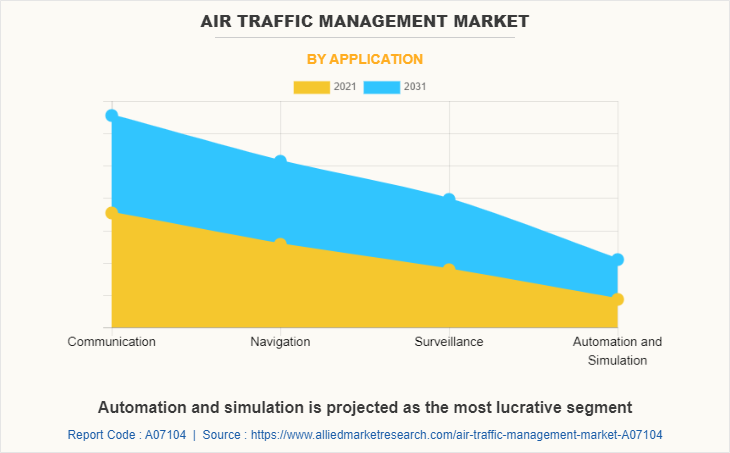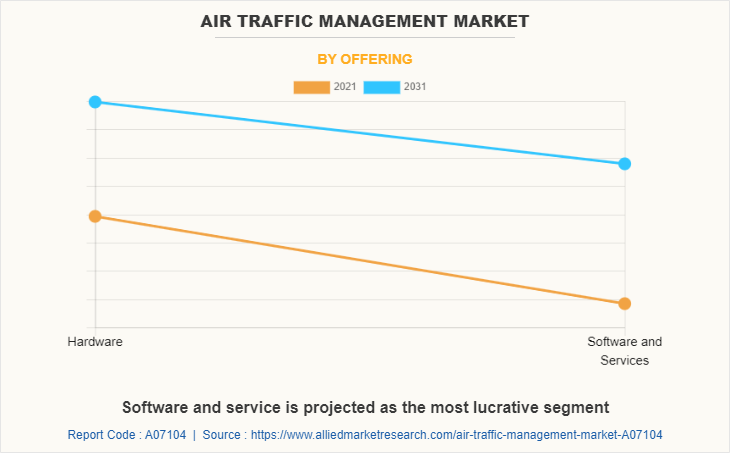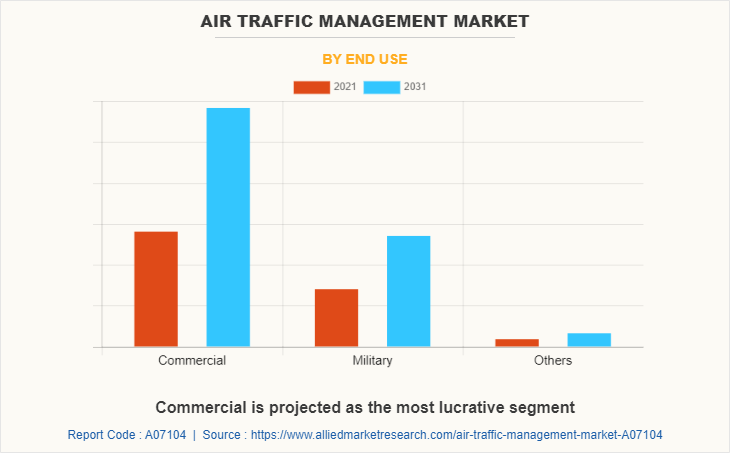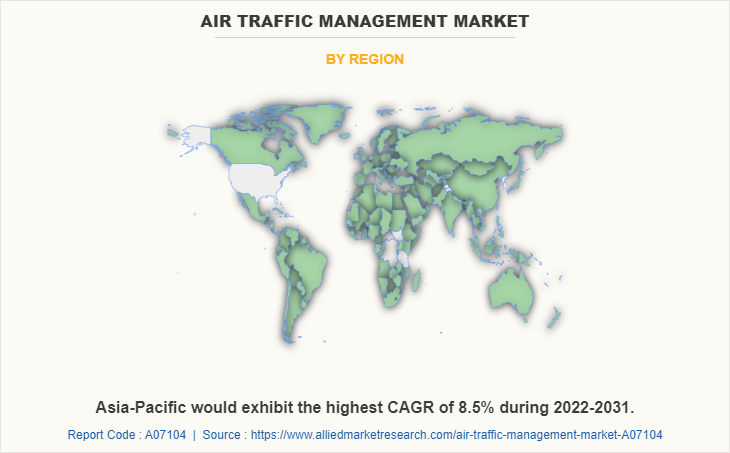The global air traffic management market was valued at $8.8 billion in 2021, and is projected to reach $17.7 billion by 2031, growing at a CAGR of 7.5% from 2022 to 2031.
Air traffic management involves control of traffic in and around airports, airport terminals and associated airspace. It enables integrated dynamic management of air traffic and makes use of air traffic services, airspace management, and air traffic flow management. These systems offer safe and air traffic control incorporating airborne and ground-based operations.

Air traffic services are utilized to efficiently regulate the flow of aircrafts in real-time to ensure their safe operations. Air traffic services includes air traffic control services, alerting services, and flight information services. Air traffic control service is provided by ground-based controllers to direct aircrafts on the ground and aids in prevention of collision between the aircrafts.
The growth of the global air traffic management market is driven by increase in air traffic across the world, modernization of air traffic management infrastructure, and greater need for improved air safety. However, potential risks associated with cyber threats, and high cost of traffic management infrastructure are factors hampering the growth of the market. Furthermore, technological advancements, and greater demand for air traffic solutions from emerging nations are factors expected to offer growth opportunities during the forecast period.
The air traffic management market is segmented on the basis of system, application, offering, end use, and region. By system, it is classified into air traffic services, air traffic flow management, and others. By application, it is fragmented into communication, navigation, surveillance, and automation and simulation. By offering, it is categorized into hardware, software and services. By end use, it is segmented into commercial, military, and others. By region, the report is analyzed across North America, Europe, Asia-Pacific, and LAMEA.

North America includes the U.S., Canada, and Mexico across which the air traffic management market has been studied. The North America air traffic management market is expected to grow during the forecast period, due to the adoption of new technologies for air traffic management to enhance airport operations. Several companies are receiving contracts from defense organization to deliver improved air traffic management systems to enhance communication capability of defense organization, which fuels the growth of the market. For instance, in April 2022, Raytheon Intelligence & Space, received a contract from USAF Nuclear Weapons Centre, under which the company completed the installation of first Global ASNT (Aircrew Strategic Network Terminal) System for the U.S. Air Force. The new system will provide advanced command and control capabilities to the U.S. Air Force’s nuclear bomber fleet.
In the U.S., few cities are entering into several collaboration and partnerships with the key players operating in air traffic management market for the modernization of regional airports in their regions, which contribute in the growth of the market. For instance, in April 2022, Kongsberg Defence & Aerospace and the City of Concord, signed a partnership agreement for the modernization of Concord-Padgett Regional Airport’s air traffic control system. The Concord-Padgett regional airport will be the first to test remote tower technology. The agreement will focus on replacing traditional air traffic control towers with a remote tower.
In June 2022, the Canadian government announced contribution of up to $39.2 million to enhance safety, & performance of Canada’s air transportation system. Canadian government will contribute up to $34.5 million to implement technology to enhance air traffic management. In addition, the Canadian government will also contribute up to $31.2 million to enhance infrastructure & technology at four airports such as Montreal-Trudeau International Airport, Toronto Pearson International Airport, Calgary International Airport, and Vancouver International Airport.
Some leading companies profiled in the air traffic management market report include Thales Group, Raytheon Technologies Corporation, L3Harris Technologies Inc., Indra Sistemas S.A., Saab AB, Northrop Grumman Corporation, BAE Systems, Honeywell International Inc., Advanced Navigation and Positioning Corporation, and Lockheed Martin Corporation. The leading companies are adopting strategies such as product launch and collaboration to strengthen their market position.
In December 2021, Thales Group and Aeronav received a $11 million contract from Civil Aviation Authority of Haiti to provide new CNS/ATM (Communication, Navigation Surveillance/Air Traffic Management) systems to upgrade and enhance air traffic management capabilities. This $11 million contract will be financed by the Government of Haiti and InterAmerican Development Bank. In addition, under this contract, Thales will deliver its TopSky-AIM solution, TopSky-ATC en route control & tower management solution, ADS-B automatic dependent Surveillance system, and RSM970S monopulse secondary surveillance radar.

Increase in air traffic across the world
Increase in air traffic has been witnessed over the years, owing to the introduction of low-cost flights. Rising air passenger traffic has encouraged airline companies to expand their aircraft fleet and enhance comfort level and services in both domestic and international flights. The Boeing’s annual marketplace outlook predicts the worldwide fleet of industrial airplanes will climb increase from 25,900 in 2019 to 49,405 planes through 2040, with nearly ninety percentage90% comprising planes with new developments to cater to the growing demand.
Similarly, Airbus predicts that over the next 20 years the demand for new aircraft will gradually shift from fleet growth to accelerating replacement of older, less fuel-efficient aircrafts. This means there will be need for more than 39,000 new passenger and freighter aircrafts, including replacement of around 15,250 aircrafts.
Air transportation is considered as the safest mode of transportation when compared with all the other modes of transportation. In addition, global increase in population is anticipated to create demand for additional aircrafts and airports to facilitate the ease for air transportation, which is expected to drive the market growth during the forecast period.
According to IATA (International Air Transport Association), the number of air passengers is projected to reach 7.2 billion by 2035. The significant increase in air traffic requires greater efficiency and air transportation safety. The aviation industry is increasingly investing in advanced solutions to offer secure operations of air traffic management systems.
Modernization of air traffic management infrastructure
Countries across the world are moving toward digital solutions and adopting AI and Machine Learning, automation, cloud computing, and blockchain based air traffic management solutions. SESAR is already delivering solutions in the form of satellite-based navigation technologies, digital towers and low-cost surface surveillance systems. Adoption of these technologies offer improved efficiency, accessibility and resilience at reduced cost. The SESAR roadmap establishes automation as the key facilitator of its aim to digitalize Europe’s aviation infrastructure. SESAR is a joint undertaking by Europe’s aviation experts to use smart technologies, from artificial intelligence to satellite-based solutions, to enable a more automated and resilient system that can meet Europe’s demands for air travel while minimizing delays and environmental impacts. Improvements in ATM and aircraft operations are estimated to contribute to reducing CO2 emissions in the short to medium term.

Greater need for improved air safety
The demand of air travelers is increasing the need to offer enhanced safety and efficiency to offer improved customer experience. Governments are investing in modernized ATM solutions to reduce streamline traffic and ensure safe and timely operations. Increase in passenger safety concerns have been observed across the world. Airline operators are investing in advanced and high-quality solutions to prevent accidents and offer safe travel to their passengers, which is a key factor contributing toward the air traffic management market growth.
SESAR defines, develops and deploys technologies to transform air traffic management in Europe and ensure safe operations of aircrafts. Founded by the European Union and Eurocontrol, the SESAR JU has 19 members, who together with their partners and affiliate associations represent over 100 companies working in Europe and beyond. The SESAR JU also works closely with staff associations, regulators, airport operators, airspace users, the military and the scientific community to offer enhanced safety to passengers through development of advanced ATM solutions.
High cost of traffic management infrastructure
The air traffic management system at any airport constitutes more than 20% - 50% of the overall running cost of the airport. In addition, various governments are spending heavily to install advanced air traffic management solutions for enhanced air traffic management. For instance, Delhi IGI Airport is now equipped with the India’s tallest ATC tower with 102 meters of height. This installation is expected to smoothen the traffic flow at the busiest airport. Further, the total cost of setting up the new ATC tower and its facilities was around $50 million. Therefore, high cost of ATM systems may hinder the growth of the global air traffic management market.
Technological advancements
AI is one of the top drivers of technology that is influencing the aviation industry. AI applications are being applied to the flight planning environment of Airlines to address the existing challenges regarding capacity, connectivity, forecasting, pollution, delay management, and safety. Several technology innovators have designed and introduced AI-based platforms to overcome existing and upcoming challenges of increased congestion in the airspace. Several AI-based solutions are being used while others are in testing stages.
Searidge Technologies offers a range of digital airport solutions and remote tower. It focuses on development of solutions to improve efficiency and safety in the aviation industry. Seardige AI platform named “Aimee” simplifies the procedure of configuring and training ANNs (Artificial Neural Networks) with huge and complex data sets, enabling aircraft’s image and geolocation tracking to ensure the availability of runway for the next aircraft to land in sequence. It is already being used at London’s Heathrow International airport to replace the runway views of air traffic controllers when the clouds and fog make the tower’s vision unclear.

Key Benefits For Stakeholders
- This report provides a quantitative analysis of the market segments, current trends, estimations, and dynamics of the air traffic management market analysis from 2021 to 2031 to identify the prevailing air traffic management market opportunities.
- The market research is offered along with information related to key drivers, restraints, and opportunities.
- Porter's five forces analysis highlights the potency of buyers and suppliers to enable stakeholders make profit-oriented business decisions and strengthen their supplier-buyer network.
- In-depth analysis of the air traffic management market segmentation assists to determine the prevailing market opportunities.
- Major countries in each region are mapped according to their revenue contribution to the global market.
- Market player positioning facilitates benchmarking and provides a clear understanding of the present position of the market players.
- The report includes the analysis of the regional as well as global air traffic management market trends, key players, market segments, application areas, and market growth strategies.
Air Traffic Management Market Report Highlights
| Aspects | Details |
| Market Size By 2031 | USD 17.7 billion |
| Growth Rate | CAGR of 7.5% |
| Forecast period | 2021 - 2031 |
| Report Pages | 256 |
| By System |
|
| By Application |
|
| By Offering |
|
| By End Use |
|
| By Region |
|
| Key Market Players | Honeywell International Inc., Saab AB, Northrop Grumman Corporation, Thales, L3Harris Technologies, Inc., Advanced Navigation and Positioning Corporation, Lockheed Martin Corporation, BAE Systems plc, Raytheon Technologies Corporation, Indra Sistemas, S.A. |
Analyst Review
The global air traffic management market is expected to witness growth due to rise in safety concerns and modernization of existing air traffic management infrastructure.
Automation and digital technologies are increasingly being deployed in air traffic control and management. High-definition (HD) cameras, automatic surveillance-broadcast (ADS-B) technology and remote sensing technologies are being adopted across various countries. These technologies enable reception of images from camera masts by remote centralized air control centers to provide a comprehensive view of the airfield for improved awareness for controllers. Digital tower technologies offer increased operational efficiency, safety and flexibility leading to enhanced productivity and reduced maintenance needs of systems and equipment.
New airports in North America and Europe are expected to adopt digital air traffic control, whereas existing highly congested airports are likely expected to replace traditional towers before they reach the end of their economic life for greater efficiency and safety. Innovations in satellite-based navigation technologies, digital remote towers and low-cost surface surveillance systems are expected to increase the performance of air traffic management solutions. Increase in adoption of virtualization has been observed. Early trials by EUROCONTROL on harnessing virtualization to enhance planning and operational activities have shown to boost efficiency and predictability by 20-30%. Single European Sky ATM Research (SESAR) states that intelligent automation is a key driver of ATM market, which is expected to lead to savings of 79,000 tons of CO2.
The key players profiled in the study include Thales Group, Raytheon Technologies Corporation, L3Harris Technologies Inc., Indra Sistemas S.A., Saab AB, Northrop Grumman Corporation, BAE Systems, Honeywell International Inc., Advanced Navigation and Positioning Corporation, and Lockheed Martin Corporation.
The global air traffic management market was valued at $8.8 billion in 2021, and is projected to reach $17.7 billion by 2031, registering a CAGR of 7.5% from 2022 to 2031.
The largest regional market is Asia-Pacific.
The leading application is communication.
The upcoming trends in the air traffic management market include modernization of air traffic management infrastructure and greater demand from emerging economies.
Loading Table Of Content...


